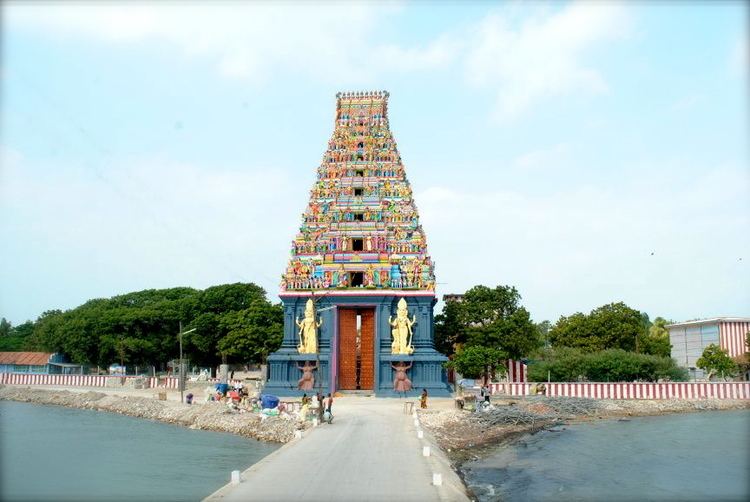Country Sri Lanka DS Division Islands South | ||
 | ||
Pilgrimage to nainativu island and nagadeepa purana viharaya sri lanka
Nainathivu or Nainatheevu (Tamil: நயினாதீவு), (also known as Manipallavam (Tamil: மணிபல்லவம்), or Nagadeepa (Sinhalese: නාගදීපය)) is a small but notable island off the coast of Jaffna Peninsula in the Northern Province, Sri Lanka. The name of the island alludes to the folklore inhabitants, the Naga people. It is home to the Hindu shrine of Shree Nagapooshani (Bhuvaneswari) Amman; one of the prominent 64 Shakti Peethas, and the Buddhist shrine Nagadeepa Vihare. Historians note the island is mentioned in the ancient Tamil Sangam literature of nearby Tamil Nadu (such as Manimekalai)) and ancient Buddhist legends of Sri Lanka (such as Mahavamsa). Ptolemy, a Greek cartographer, describes the Tamil territory including islands around the Jaffna peninsula as Nagadibois in the first century CE.
Contents
- Pilgrimage to nainativu island and nagadeepa purana viharaya sri lanka
- Map of Nainativu Sri Lanka
- History
- Naga People
- Decline of Naga identity and assimilation
- Demography
- References
Map of Nainativu, Sri Lanka
History
Nāka Tivu / Nāka Nadu was the name of the whole Jaffna peninsula in some historical documents. There are number of Buddhist myths associated with the interactions of people of this historical place with Buddha. The two Tamil Jain and Buddhist epics of the second century - Kundalakesi and Manimekalai - describe the islet of Manipallavam of Nāka Tivu/Nadu, this islet of the Jaffna peninsula, from where merchants came to obtain gems and conch shells. The protagonists of the former story by Ilango Adigal visited the island. In the latter poem by Sīthalai Sāttanār, the sea goddess Manimekhala brings the heroine to the island, where she worships Lord Buddha. She is also told of the petrosomatoglyph atop the mountain of the main island and a magic bowl Amudha Surabhi (cornucopia bowl) that appears once every year in a lake of the islet.
The Manimekhalai and the Mahavamsa both describe Buddha settling a dispute between two Naga princes over a gem set throne seat on Nainativu. The Tamil language inscription of the Nainativu Hindu temple by Parâkramabâhu I of the 12th century CE states that foreigners landing at new ports must meet at Kayts and they must be protected, and if ships to the islet carrying elephants and horses get shipwrecked, a fourth of the cargo must go to the treasury.
Naga People
Nāka people were snake-worshippers, a Dravidian custom, and spoke Tamil based on Ptolemy's description of the Nāka people. They also likely spoke Prakrit, a language of the school of Amaravathi village, Guntur district with which the early Tamils of Jaffna had strong cultural relations during the classical period. The Nākas were a branch of the Dravidian community, and were at that time part of the Chera kingdom, and of ancient Tamilakam. Archaeological excavations and studies provide evidence of palaeolithic inhabitation in the Tamil dominated Northern and Eastern Sri Lanka and in Tamil Naadu and Chera Naadu (Kerala region). The findings include Nāka idols and suggest that serpent worship was widely practised in the Dravidian regions of India and Sri Lanka during the megalithic period.
The Nākas lived among the Yakkha, Raksha and Deva in Ceylon according to the Manimekalai and Mahavamsa. Cobra worship, Tamil speech and Keralan cuisine extant in Jaffna Tamil culture from the classical period attests to the Nāka's heritage.
Sangam literature details how the ancient Tamil people were divided into five clans (Kudi) based on their profession during the Sangam period, where the Nāka clan, who were in charge of border security guarding the city wall and distant fortresses, inhabited the Coromandel Coast - South Tamil Nadu, East Tamil Nadu and North Sri Lanka. The name Nāka was either a corrupted version of the word Nayinaar or may have been applied to this community due to their head covering being the shape of a hydra-headed cobra in reverence to their serpentine deities. British historian and author of "Ancient Ceylon" considers the Nāka to be an offshoot of the Nayars of Kerala Ancient Tamil epic Manimekalai and the Sri Lankan history book Mahavamsa both mention a dispute between two Naga kings in northern Sri Lanka. The Manimekalai and archaeological inscriptions refer to the Chola-Naka alliance and intermarriange being the progenitor of the Pallava Dynasty of Tamilakam.
Decline of Naga identity and assimilation
The Nagas are likely to have lost their identity over time, due to their loss of power and the formation of alliances with the new settlers of Sri Lanka. It is believed the original populations control over the island declined and they moved to their stronghold in the North of Sri Lanka. Nainativu being called "Nayinaartheevu" and "Nagadeepa" since ancient time attest to this. The Sri Lankan Tamil people of Nainativu are descendants of the Naga people. They continue to worship their patron Nayinaar deity (a five headed cobra) even today within the sanctum sanctorum of the Nainativu Sri Nagapooshani Amman Temple. Historical records show that this temple was established by the Nagas from Chola, Pandiyan, and Chera Kingdoms who travelled on route to the early Jaffna Kingdom. The temple continues to be a major pilgrimage location for Sri Lankan Tamils, and Indian Tamils of Southern coastal regions of Tamil Nadu despite the decline of the Naga identity. These communities can trace their roots to the Nagas, who were Dravidians who spoke Tamil and other related languages. Archeological evidence of Naga settlements have been found in many parts of Tamil Nadu, Kerala (which was formerly Chera Nadu), and other South Indian sites such as Aathicha Nallur near Thirunelveli in Southern Tamil Nadu.
Demography
The population of the island is approximately 2,500 Sri Lankan Tamils and about 150 Muslims. Many Tamils of Nainativu origin, live in various cities and towns of India, Europe, Australia, and North America as part of the Sri Lankan Tamil diaspora.
